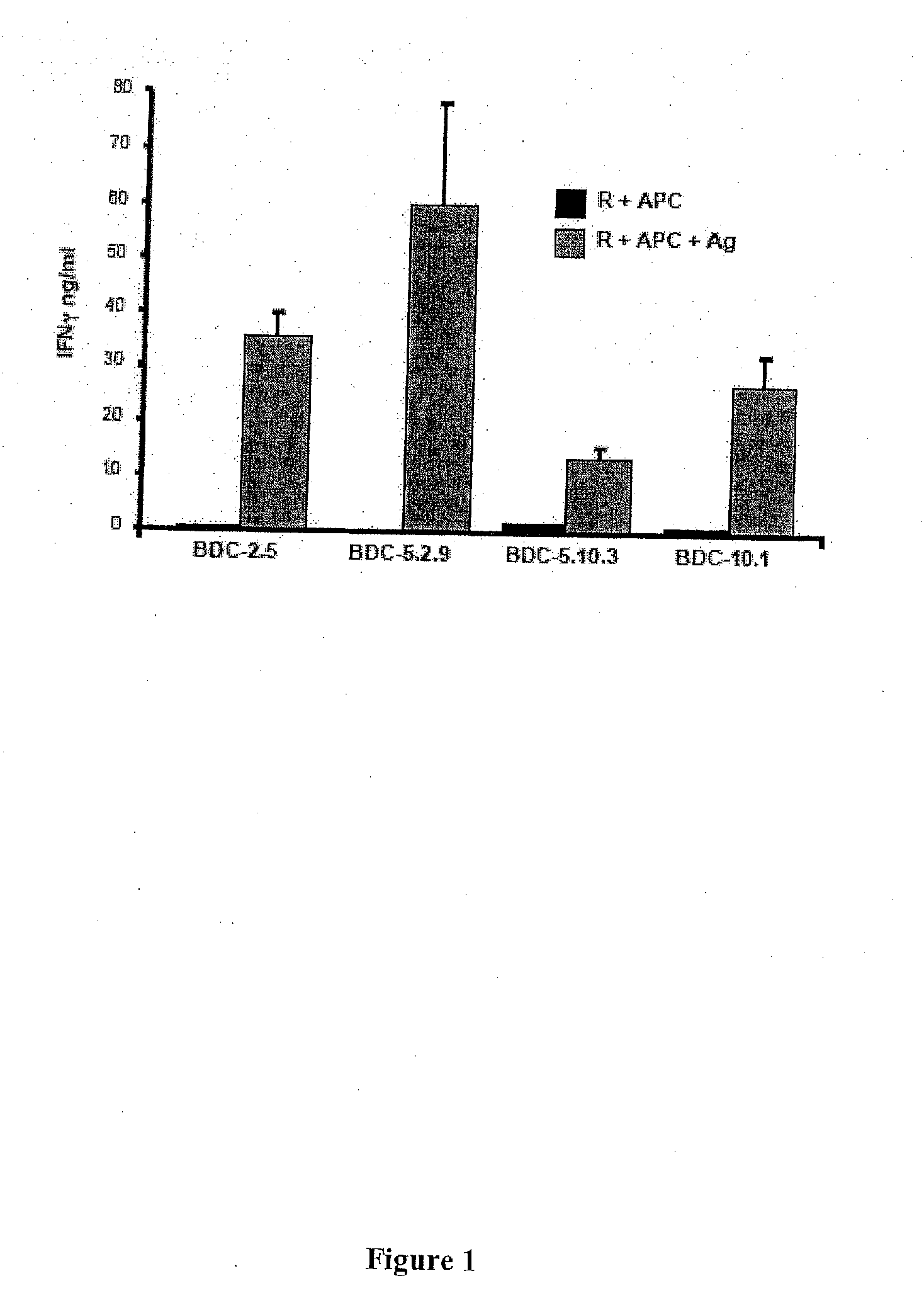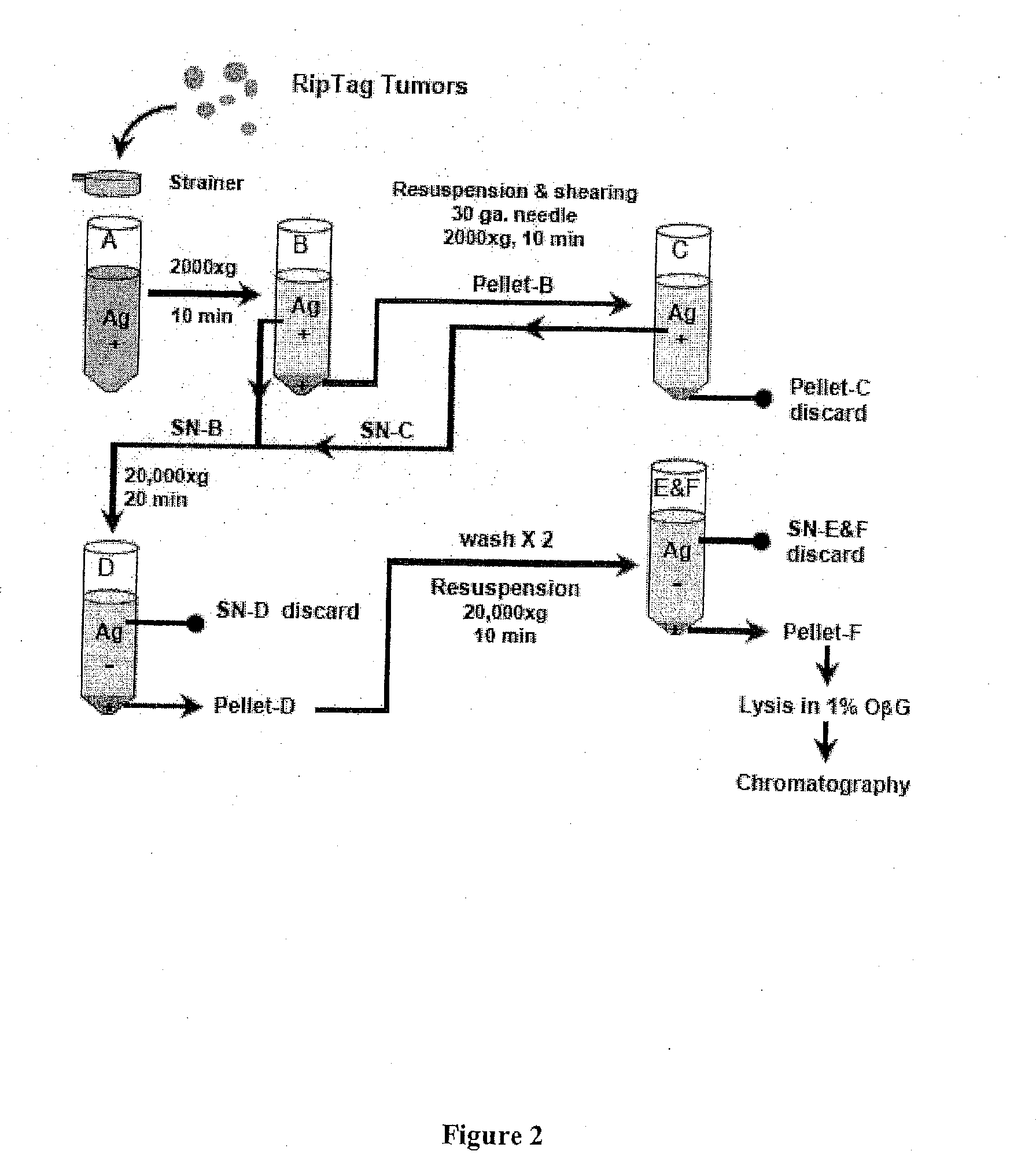Methods and compositions for the treatment of autoimmune disease
a technology for autoimmune diseases and compositions, applied in the field of development and treatment of autoimmune diseases, can solve the problems of not using sequence alignments, no evidence, and proving more difficult to define mhc class ii binding motifs based on sequence alignments
- Summary
- Abstract
- Description
- Claims
- Application Information
AI Technical Summary
Benefits of technology
Problems solved by technology
Method used
Image
Examples
example i
Assay For Antigenicity
[0386]This example describes an assay of diabetogenic T cell clones from a BDC panel by a reaction with autoantigens from a pancreatic β-cell membrane preparation.
[0387]To obtain antigenic material for separation by chromatographic procedures, a crude membrane preparation was made from beta tumor cells isolated from freshly excised NOD RIPTag adenomas. Adenomas were harvested from the mice when they were about 4 months of age and processed into membrane preparations and used immediately or frozen for later use.
[0388]Initially, the RIPTag tumor cells are disrupted through a 30 gauge needle strainer and subjected to low speed centrifugation (2000×g ˜10 min) to remove cellular debris. See, FIG. 2. Subsequently, a whole-cell membrane preparation (i.e., for example, insulin granules) is obtained through high-speed centrifugation. The final pellet is either distributed into aliquots and frozen, or directly solubilized in octyl-beta glucoside (OβG)-containing lysis bu...
example ii
Chromatography Antigen Purification
[0390]Antigenic material can be obtained in the form of a membrane preparation made from NOD RIPTag beta tumor cells according to the methods described in accordance with Example I.
[0391]Before fractionation and throughout the chromatographic separations, samples are taken for each step to assess protein content and antigenicity. Tracking antigenicity is dependent on sensitive and reliable bioassays. For example, an IFNγ response is faster and much more reproducible and accurate than the standard T cell proliferation assay. Antigenicity for the T cell clones is detected through T cell responses to a source of antigen and NOD APC. See, FIG. 1.
[0392]The T cell clones are maintained in culture by periodic re-stimulation with irradiated NOD splenocytes and islet cells or β-membrane. To assay for antigen, resting responder T cells (i.e., for example, the cells at the end of the two-week restimulation period) are co-cultured for 24 hr with elicited perit...
example iii
Two Dimensional Gel Electrophoresis
[0397]This example, describes further isolation and enrichment of beta cell membrane proteins subsequent to chromatographic steps in accordance with Example II.
[0398]Initially, proteins are dialyzed in order to be resuspending in a buffer compatible with 2DGE. Alternatively, proteins may be precipitated with methanol / chloroform or TCA / Acetone using standard procedures. Protein samples analyzed using DiGE are processed in accordance with the manufacturers instructions and in duplicate to reduce the occurrence of falsely positive or negative results.
[0399]Briefly, RIP-TAG and NIT-1 chromatographically purified lysates will be individually labeled with Cy3 or Cy5 and a combined aliquot labeled with Cy2 as an internal standard. Dyes will be “switched” to decrease the likelihood of biased labeling and an additional “pick gel” will be used for protein identification. Lysates will be mixed in a 1:1:1 (Cy2:Cy3:Cy5) ratio and 2DGE performed. See, FIG. 7.
[04...
PUM
| Property | Measurement | Unit |
|---|---|---|
| time | aaaaa | aaaaa |
| Tm | aaaaa | aaaaa |
| elution volume | aaaaa | aaaaa |
Abstract
Description
Claims
Application Information
 Login to View More
Login to View More - R&D
- Intellectual Property
- Life Sciences
- Materials
- Tech Scout
- Unparalleled Data Quality
- Higher Quality Content
- 60% Fewer Hallucinations
Browse by: Latest US Patents, China's latest patents, Technical Efficacy Thesaurus, Application Domain, Technology Topic, Popular Technical Reports.
© 2025 PatSnap. All rights reserved.Legal|Privacy policy|Modern Slavery Act Transparency Statement|Sitemap|About US| Contact US: help@patsnap.com



